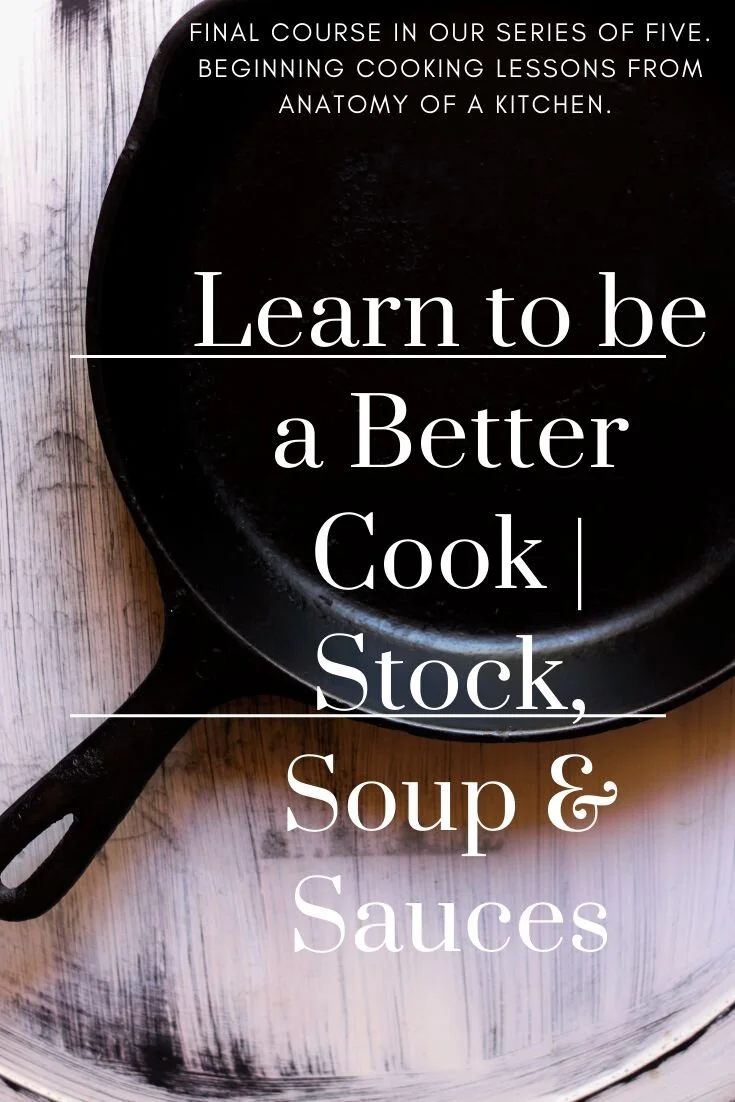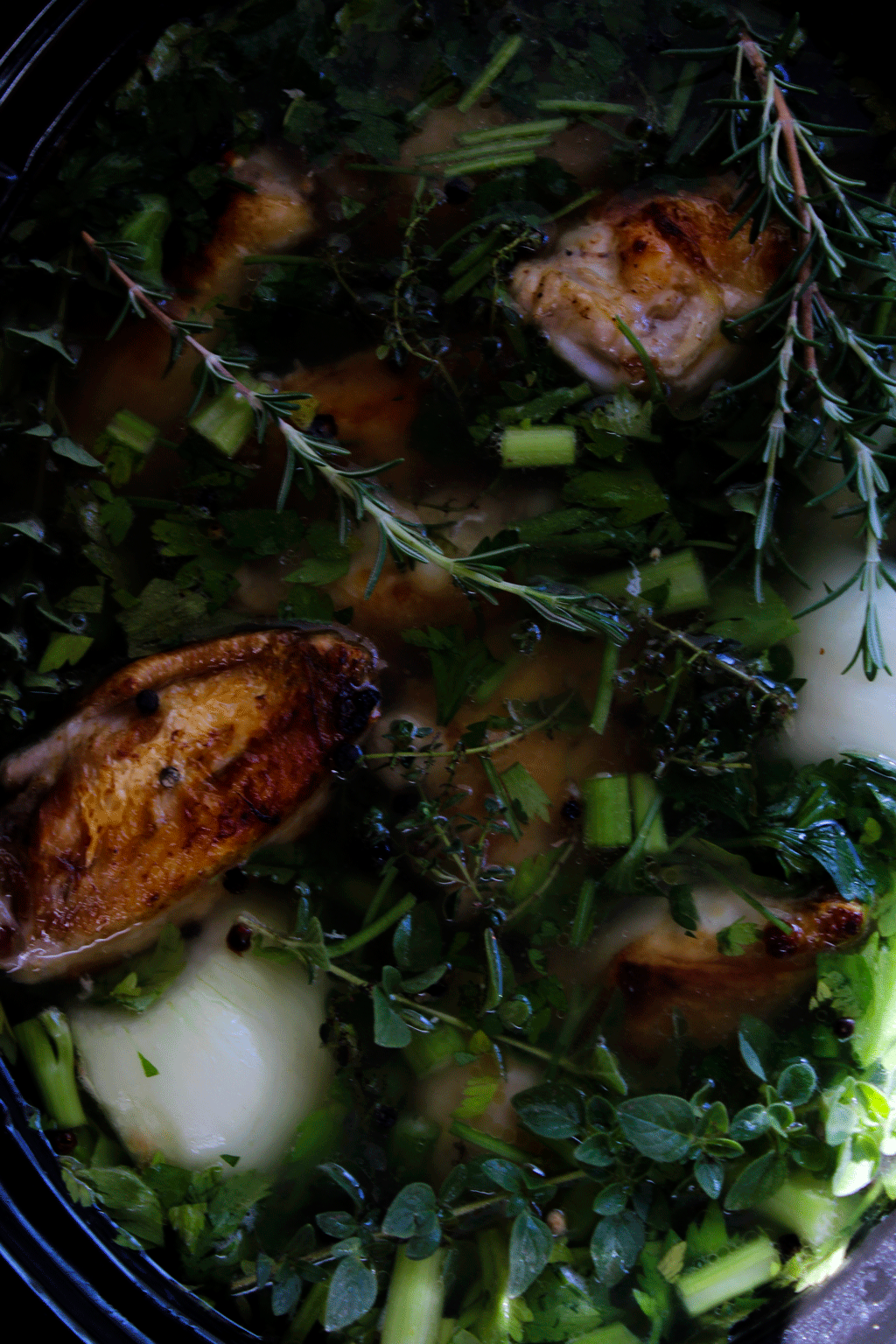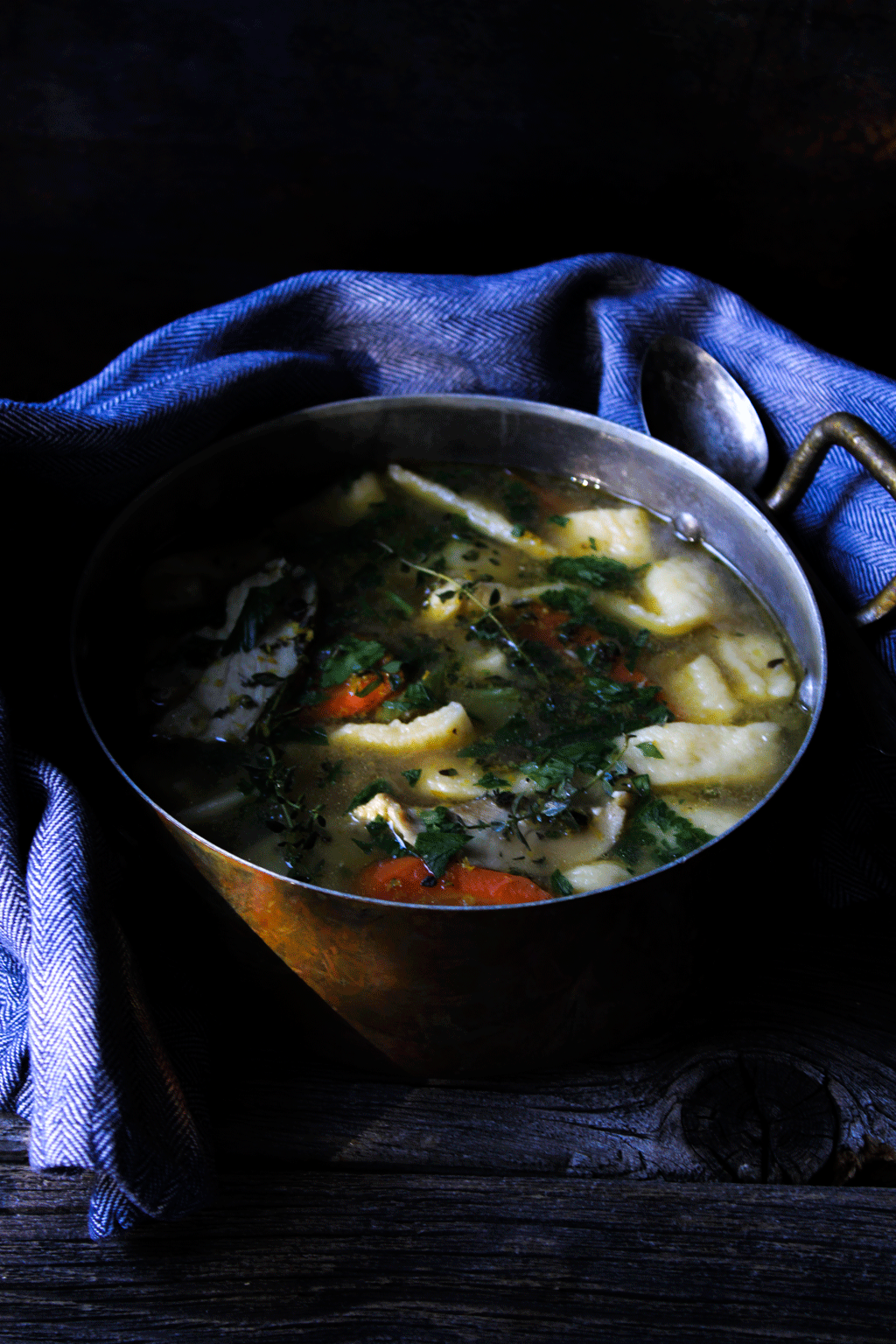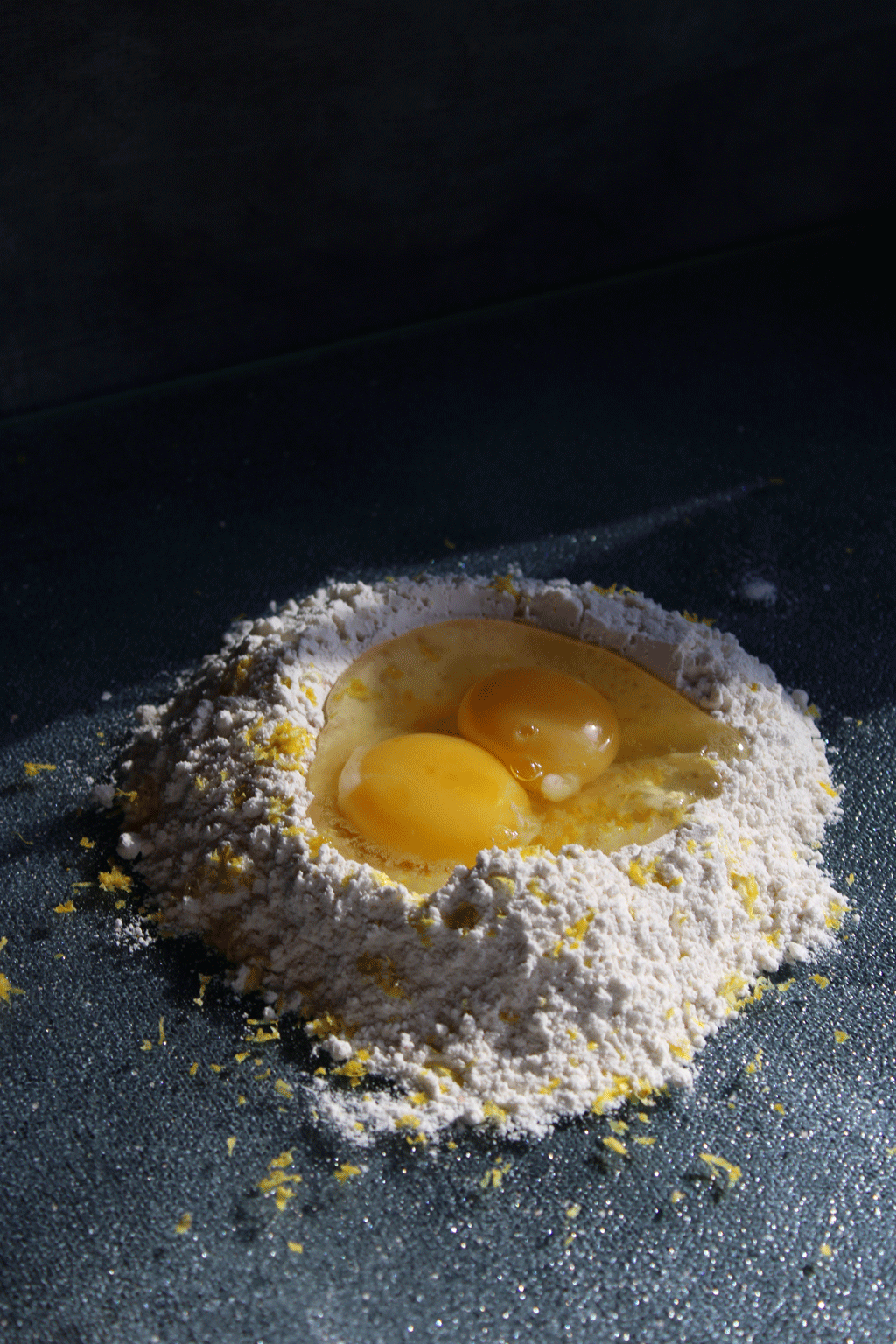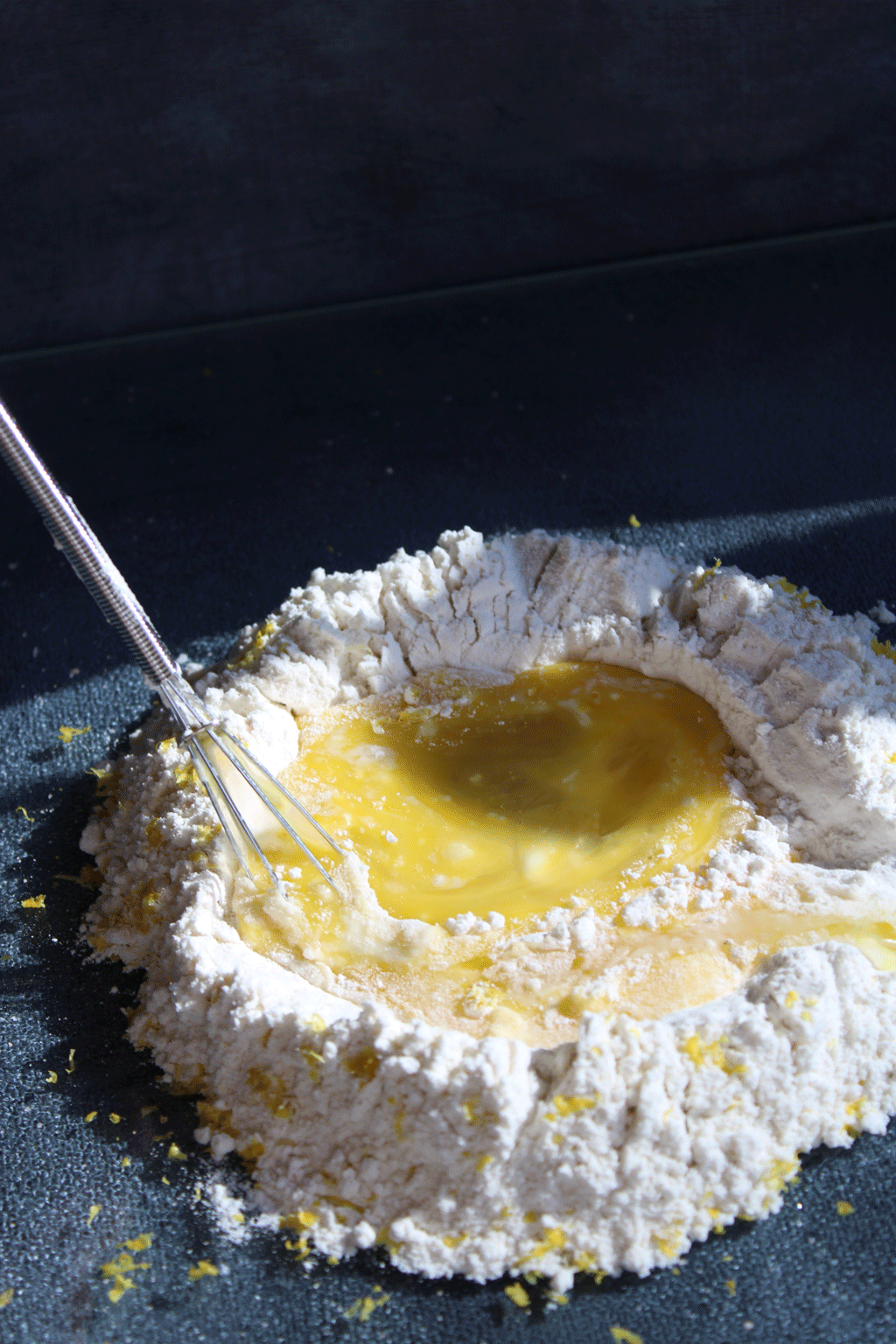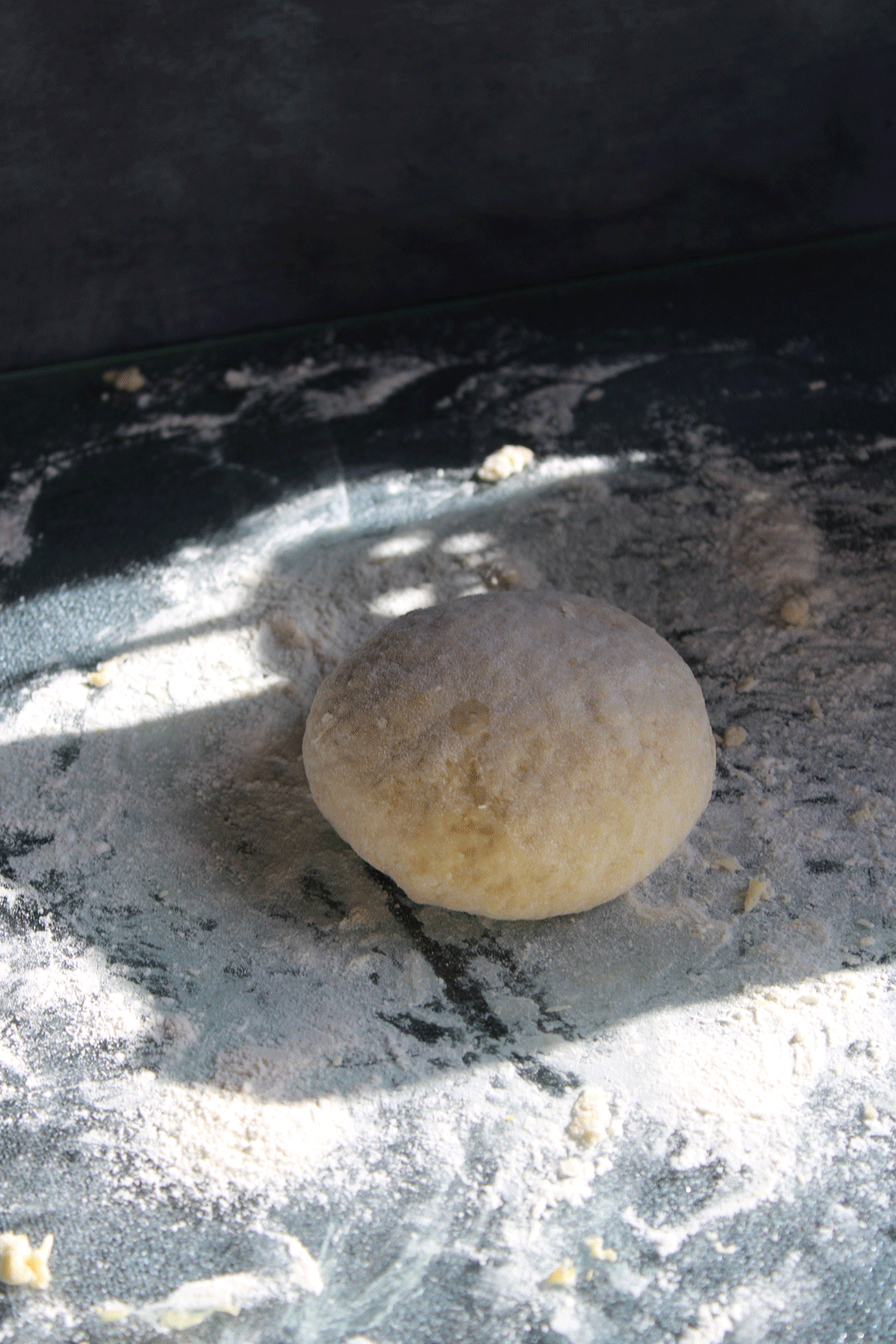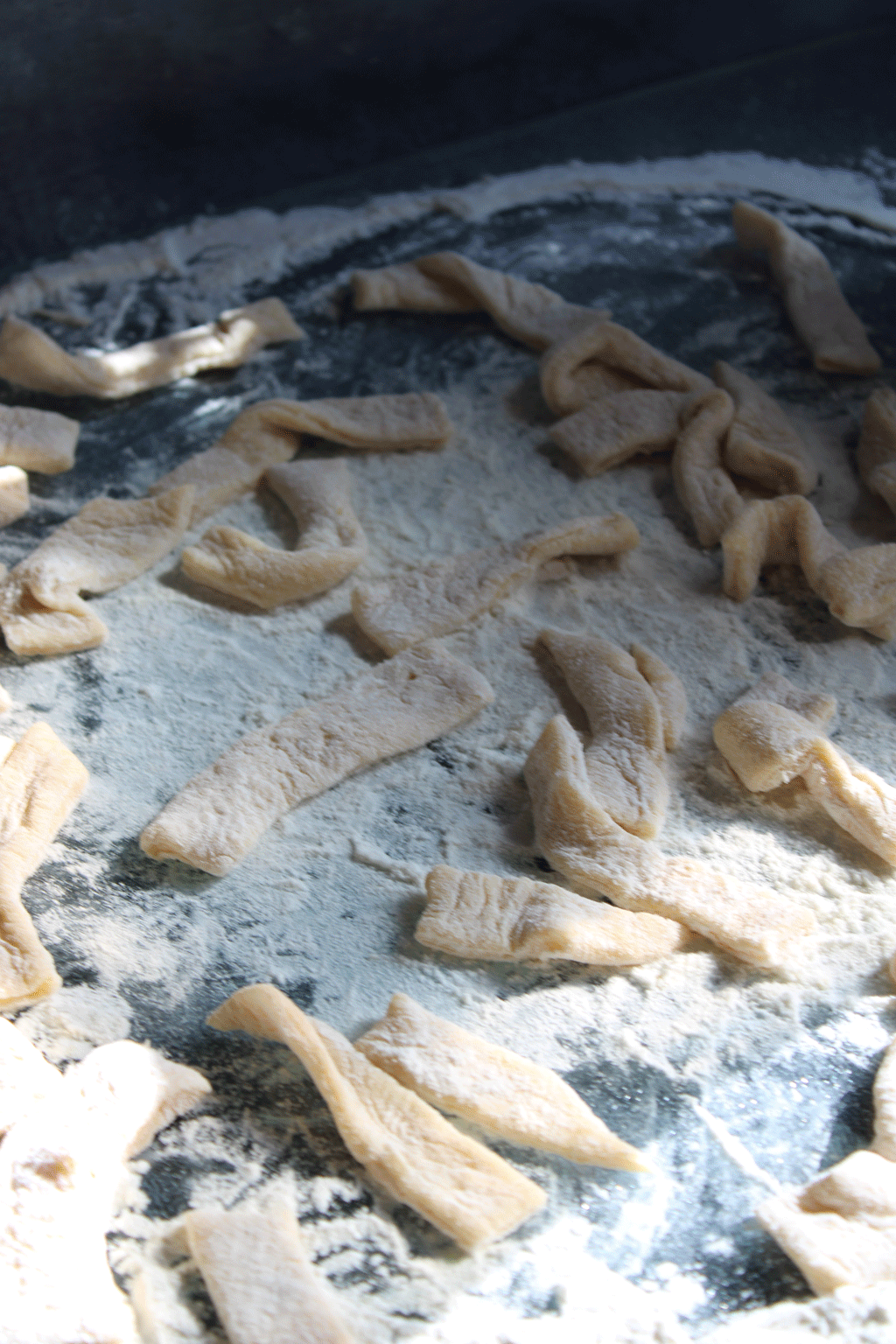Cooking Lessons | Session 5 | Stock, Soup & Sauce
Stock, Soup & Sauce
If you have followed all five lessons by now you are acquainted with the basics. They should serve as a foundation for your future culinary adventures. This final lesson in a series of five focuses on stock, soup & sauce.
Session 1- We learned about the tools of the trade.
Session 2- Mise en Place- French for everything in its place. In short, it related to having all of your recipe prepped; everything diced, minced, premeasured. At length it entails reading through the recipe to ensure that you understand the process, making certain that you have everything on hand such as ingredients & tools. And finally, everything you need should be within reach while your making your recipe.
Session 3- We focused on knife sharpening & maintenance.
Session 4- The Art of Salt taught us how to build flavor & season dishes. This section included for printables for building up pantry basics.
Session 5- Our final lesson in this beginners series; Stock, Soup & Sauce should have you well on the road to successful cooking.
“Welcome. My name is Wendi. I am a professionally trained Chef with a Degree in Culinary Arts. My experience stems from working in a commercial kitchen setting & also as a private Chef. I do not presume to be an expert in any particular area, as this world is much to vast. I do however practice my art conscientiously and passionately & I go to great lengths to ensure that the information I share with our valued readers is credible & accurate. Be passionate in what ever you do.
With love & admiration on your journey,”
Stock.
What is the value of knowing how to create a flavorful stock?
Stock consists of bones cooked down with mirepoix & herbs into a flavorful broth. A necessity in the kitchen, it serves as a basis for soups & sauces. It is also a great stand alone. Sipping a cup of hot broth warms us head to toe. If we are feeling under the weather, nothing is quit as soothing or relaxing thanks to the natural tryptophan found in poultry. Collagen (a form of protein) released from the bones is excellent for hair, nails & digestive system. The properties of a good bone broth can aid in weight loss as well as help our bodies recover from surgery or our muscles from exercise. It’s a highly valued staple in the Keto diet as well as the Paleo diet.
Characteristics of an excellent stock.
A quality stock should deliver a full mouth feel from a generous amount of natural gelatin derived from the bones. I recommend chicken wings for chicken stock as they have a great deal of cartilage & they are the least amount of work. Simply roast for 20 minutes or so in a hot oven or pan fry until skin is crisped up. Alternately, use a roasted carcass. By this I do not mean the bones from a rotisserie chicken, although this may give you some flavor it will contribute little in the way of body & gelatin as it has already given what it has to give. I’m talking about carving a whole raw chicken (reserving the the hind quarters & breast for another purpose) & roasting up the carcass with the wings in a very hot oven (450f) for about 20 minutes. The whole point & benefit of a bone broth is the bones. I do not recommend putting completely raw chicken directly into the broth as it tends to cloud up your stock with impurities. So either roast, pan fry or cook in a pot of boiling water for 5 minutes or so to remove impurities. My preference is roasting. It’s less time consuming & yields a nice roasted flavor profile to the finished stock. For a rich beef stock I recommend ox tail (which is taken from a cows tail, not ox) or neck bones using any of the methods above to remove impurities.
A good stock should be rich & flavorful. This comes from the roasting of the bones as well as mirepoix & herbs. To salt or not to salt? Most chefs do not add salt to their stocks because they are most often used in conjunction with a recipe that adds salt. Not adding salt to the actual stock gives them greater control of the recipes out come. As for me, I salt my stock. Mainly because I use a great deal of it for simply sipping therefor I want it properly season from the go. If I use it in a recipe, say a soup, I know that I will have to adjust the amount of salt in the recipe.
Adding mirepoix (onion, celery, carrot) contributes to flavor, nutrients as well adding body to your stock. I peel my onion & quarter. Celery, you can use scraps such as celery leaves & less desired stalks, rinsed & cut into chunks. Carrots simply need to be rinsed or scrubbed of possible debris, not need to peel, cut into chunks. Most stocks do not contain garlic as it tends to overwhelm. I add garlic to mine because I am a garlic lover & it has wonderful medicinal qualities. The addition of herb & spices serves to add complexity as well as lending an earthy balance to your stock. Minimum, you need parsley. I use a combination of parsley, rosemary, lemon thyme & oregano with bay leaf & pepper corns. Some chefs tie these up in a sachet of cheesecloth with cooking twine & drop it into the stock so it can later be removed. This is referred to as a bouquet garni. Personally, I free float my herbs & aromatics, as the broth gets strained in the end anyway & I feel it adds to the potency.
the making of a stock
A few basic ingredients & your stock simmers away in silent submission in a corner of the kitchen requiring no attention. Though there are decent quality bone broths on your grocers shelves, nothing compares to fresh homemade bone broth. Not in flavor, not in quality. Components of a basic chicken stock as well as a recipe are listed below.
Wendi’s Basic Chicken Stock
Wendi’s Basic Chicken Stock
yeilds 8 cups of strained stock
2 qts. cold water
1 Tbsp. lemon juice (or apple cider vinegar)
2 lbs. chicken wings with tips
1 large onion, peeled & quartered
2 carrots, rinsed & quartered
tops & leaves of a head of celery
1/3 end of a bunch of parsley, the stems with some leaves (in a stock, you use the less desirable parts, ‘the scraps’ reserving the fine leaves for another purpose)
2 sprigs of fresh rosemary
4 sprigs of lemon thyme
3 sprigs of fresh oregano
4 dried bay leaf
1 Tbsp. of pepper corns
1 Tbsp. salt
Roast wings in a hot oven (450f) for 20 minutes. Combine all ingredients in a crock pot, instant pot or a large sauce pot. *Simmer for 3 hours. Strain stock through a fine mesh strainer. Cool to 70f. Refrigerate or freeze according to use.
*Define simmer. The Chef I trained under, Chef Brad Peters, referred to it this way. Simmer is to boiling as smiling is to laughing. Thus, you want your stock smiling. Not laughing. I thought that a brilliant enough analogy to share.
Soup.
Taylor’s Favorite Lemon Chicken Soup with Hand Rolled Pappardelle Pasta
A soup need not be elaborate to delight. The very earliest Restaurants served soup, which were referred to as restoratives. It is one of the simplest & most primitive meals, intended to restore the weary traveler. There are a few basic bases for soup; broth, cream & tomato bases. We take the stock above, add a few ingredients & create from it a bowl of comfort that transcends time. If you master only one thing this fall, let it be homemade soup. And homemade bread. .. Because what could be better than a soul soothing bowl of soup & a crusty hunk of warm buttered bread? Here is a simply recipe for Focaccia. If you are ready for something more advance, try this Rosemary & Roasted Garlic Bread Rustica.
Taylor’s Favorite | Lemon Chicken Soup | with Hand Rolled Pappardelle Pasta
serves 4
Soup Base
2 Tbsp. olive oil (or canola)
2 large shallots, diced (or 1 onion)
2 carrots, peeled & sliced thick on the bias
2 stalks of celery, sliced on the bias
2 plump cloves of garlic, minced
3 bay leaf
1 qt. of chicken broth from above (or purchased bone broth)
3 cups of rotisserie chicken, cut into strips (mainly juicy thigh meat)
1 batch of hand rolled lemon Pappardelle Pasta (recipe below or an 8 oz. of Pappardelle egg pasta)
1 Tbsp. lemon thyme, minced
1/4 cup flat leaf parsley, chopped
zest of 1 lemon
1 Tbsp. fresh lemon juice
salt & white pepper to taste
In a large sauce pot, heat oil over medium heat until it begins to shimmer. Saute onion, carrot & celery for a few minutes then add garlic & bay leaf, saute for 1 minute. Add broth. Simmer until broth is hot then add chicken, pasta, thyme & parsley. Continue to simmer until vegetable are tender & pasta is cooked through, about 10 minutes. Remove from heat, remove bay leaf & season with zest, lemon juice & white pepper.
Hand Rolled Lemon Pappardelle Pasta
1 cup bread flour (plus extra for dusting)
1/4 tsp. salt
zest of 1 lemon
2 large eggs, room temperature
Mound flour on a work surface & make a well in the center. Sprinkle with salt & lemon zest. Crack eggs into the well & beat slightly either with your fingers or a small whisk, slowly pulling flour in from side. Continue mixing eggs into flour until it full incorporated adding just a bit of flour as needed. Knead 5-10 minutes to form a smooth & uniform ball. Cover with a slightly damp tea towel & allow to rest 10 minutes. Flatten out with your ands then roll out with a rolling pin to a thickness of 1/4”. Use a sharp knife or better yet, a pizza cutter to cut into strips; 1/2” wide by 2” long. Toss strips with a bit of flour to keep them separate, set aside to dry. When ready to add to soup, shake excess flour off pasta using a fine mesh strainer so the flour does not cloud your beautiful broth soup.
This hand rolled pasta is thick & satisfying with a nice toothy chew. If you desire a thinner pasta then I recommend you use a pasta machine.
Sauce.
There are five mother sauces from which most other sauces are derived from. The first three are made using a Roux- which is equal parts by weight of butter & flour (usually bread flour) it serves as both a flavor componant to a sauce & a thickener. To make roux simply melt butter & whisk in flour, cook whisking until it reached the desired color. A white roux, used for bechamel cooks only a few minutes, just long enough to cook off the raw taste. Blonde roux, cooks a few minutes longer & is used for veloutes. Brown roux, used for espagnole, is cooked until it turns a light brown color & gives off a nutty aroma.
Roux + a liquid = a sauce.
There is a little more to it then what’s stated below; mirepoix, white wine, lemon juice, seasonings such as salt, white pepper, nutmeg may also be added. But essentially, it’s that easy. Most of these sauces you have had & just didn’t realize it. If you have had chicken pot pie, then you have had chicken veloute sauce. If you have ever had homemade macaroni & cheese then you have likely had a variation of bechamel sauce.
Veloutes. Roux + Chicken Stock | Essentially a Chicken Gravy.
-Add some fresh herbs & you have the sauce for chicken pot pie.
-Add white wine, capers & lemon juice & you have piccata sauce.
Bechamel. Roux + Milk | White Sauce.
- Add cheddar cheese & you have the sauce for homemade macaroni & cheese or au gratin potatoes.
-Add roasted garlic, white wine & parmesan & you have alfredo sauce for fettucine or chicken.
Espagnole. Roux + Beef Stock | Essentially a Beef Gravy.
-Add sauteed mushrooms & you a hearty mushroom sauce for meatloaf & mashed potatoes.
Tomato. Tomato + Stock | Basic tomato Sauce.
-Add sauteed onion, garlic & Italian herbs, this gives you marinara (though most American cooks do not use stock in a marinara). Add sausage or ground beef to it & you have Bolognese (meat-sauce/spaghetti).
-Add…..& you have a creole sauce.
Hollandaise. An emulsion of butter, egg yolks & lemon juice.
Thank you for joining us. It is our hope that these lessons served to bolster your confidence in the kitchen. As with any art, practice it with passion.

